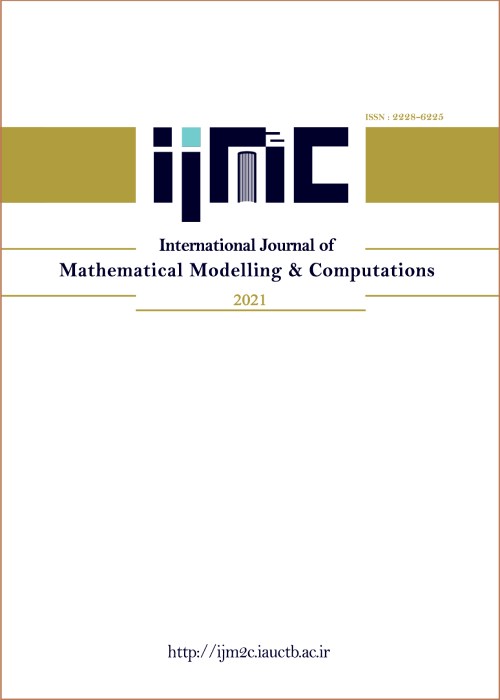فهرست مطالب

مجله بین المللی محاسبات و مدل سازی ریاضی
سال دوازدهم شماره 2 (Spring 2022)
- تاریخ انتشار: 1401/10/21
- تعداد عناوین: 6
-
-
Pages 79-87
The purpose of this paper is to locate and estimate the eigenvalues of stochastic tensors. We present several estimation theorems about the eigenvalues of stochastic tensors. Meanwhile, we obtain the distribution theorem for the eigenvalues of tensor product of two stochastic tensors. We will conclude the paper with the distribution for the eigenvalues of generalized stochastic tensors.
Keywords: Nonnegative tensors, Inclusion sets, Stochastic tensors, eigenvalue -
Pages 89-100In this paper, Electro-Magneto-Hydrodynamic flow of carbon-based nanofluids over a plane sheet is investigated. Carbon nanotubes, graphene and graphite nanon- particles are considered with water as the base fluid. The governing equations formulated for the nanofluids are reduced to nonlinear ordinary differential equations by using similarity transformations. The coupled nonlinear equations are solved numerically by forth order Runge-Kutta method coupled with shooting techique. The numerical results obtained for the skin friction coefficient, nusselt number and sherwood number, as well as the velocity, temperature and concentration profiles for different values of various parameters demonstrate good agreement with literature. The enhanced thermal transport in graphene makes it a good coolant as compared to carbon nanotubes and graphite nanofluids.Keywords: EMHD, Nanofluids, Nanoparticle, Similarity transformation, Thermal conductivity, Soret effect
-
Pages 101-114The coronavirus disease was first discovered in Malaysia on the 25th of January, 2020. The number of positive cases remained stable until March 2020, where a large spike emerged. Different exploratory data analysis tools need to be used to easily observe the trend of coronavirus infections and ascertain the end of the pandemic. Also, the growth rate of the pandemic seems to be under-reported in many countries due to some issues. In this research, we explored the reported COVID-19 data using different discrete frequency tables. The positive cases, deaths, and recoveries were organized in general cases, cumulative cases and 14 days moving cases frequency tables. The reported positive cases were displayed according to the states as states' new cases, cumulative cases, and 14 days moving cases frequency tables. The end of the pandemic can be detected when there is no infection for 14 consecutive days and was determined in the country as a whole using the cumulative cases and the 14 days moving cases general frequency tables. Whereas in the states, the states' cumulative cases and the 14 days moving cases frequency tables were used to detect the end of COVID-19 pandemic.Keywords: Coronavirus, Pandemic, Positive Cases, Death Cases, Recoveries, Exploratory Data Analysis, Discrete Frequency Table
-
Pages 115-130A human host-mosquito vector model for transmission of malaria with infow of infected immigrants is formulated. The mosquito population includes aquatic stages (eggs, larvae, and pupae) and mature stages which have highly temperature and rainfall dependent life cycles. Model analysis reveals that the model only attains two (2) endemic equilibria; one in absence of the vector population and the other in presence of the vector population. The endemic equilibrium without the mosquito vector population is unstable. The endemic equilibrium with the vector population is locally stable and globally unstable. Numerical simulations of the model reveal that the proportion of infected humans introduced into the community does not significantly change the pattern of malaria transmission.Keywords: Equilibrium points, Local stability, Global stability, numerical simulation
-
Pages 131-142In this paper, the nonlinear dynamical system modeling the effect of awareness program by media on spread of infectious disease is considered. The model is mathematically formulated by the deterministic compartmental model consisting of susceptible population, infected population, aware population and cumulative density of awareness spread by the media. Homotopy perturbation method is used to obtain the approximate solution of the governing nonlinear differential equation, which consists in determining the series solution convergent to the exact solution or enabling to built the approximate solution of the problem. Numerical solutions are obtained and the results are discussed graphically using Maple. The method allows to determine the solution in form of the continuous function, and shows the significance of awareness program driven by media in spread of an infectious disease, but due to immigration, the disease may remain endemic . The simulation analysis of the model with different parameter values confirms the analytical results.Keywords: Nonlinear system of Differential Equation, Approximate Solution, Homotopy Perturbation method, numerical simulation
-
Pages 143-152One of well-known techniques in data mining is clustering. Clustering method which is very popular is K-means cluster because its algorithm is very easy and simple. However, K-means cluster has some weaknesses, one of which is that the cluster result is sensitive towards centroid initialization so that the cluster result tends to local optimal. This paper explains the modification of K-means cluster, that is, K-means hybridization with ant colony optimization (K-ACO). Ant Colony Optimization (ACO) is optimization algorithm based on ant colony behavior. Through K-ACO, the weaknesses of cluster result which tends to local optimal can be overcome well. The application of hybrid method of K-ACO with the use of R program gives better accuracy compared to K-means cluster. K-means cluster accuracy yielded by Minitab, Mathlab, and SAS at iris data is 89%. Meanwhile, K-ACO hybrid clustering with R program simulated on 38 treatments with 3-time repetitions gives accuracy result of 93,10%.Keywords: Clustering, Data mining, K-means, Ant colony optimization, program R, Iris data

